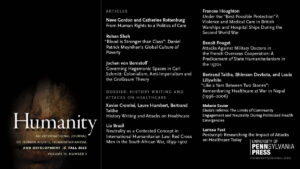What does transformative occupation look like from the vantage point of the colonized? This essay explores modalities of resistance to occupation: how local indigenous actors engaged in a liberation struggle navigate, respond, and adapt to the structural realities of indefinite occupation. By reconstructing the resistance discourse of the Palestinian Islamic Resistance Movement, Hamas during the Second Palestinian Intifada, this essay demonstrates the manner in which the movement’s resistance strategy came to encompass a political dimension. It argues that Hamas’s political engagement was not a transition away from resistance, but rather the continuation of resistance by other means.
This content is restricted to site members. If you are an existing user, please login. New users may click here to subscribe.
Current Issue

📘'Choose Your Bearing: Édouard Glissant, Human Rights and Decolonial Ethics' is now available for pre-order!
❕Grab your copy and save 30% OFF using the code NEW30 at checkout : https://edin.ac/3JIcRne
@HumanityJ
Login Status
If you are not a subscriber, you can sign up now.